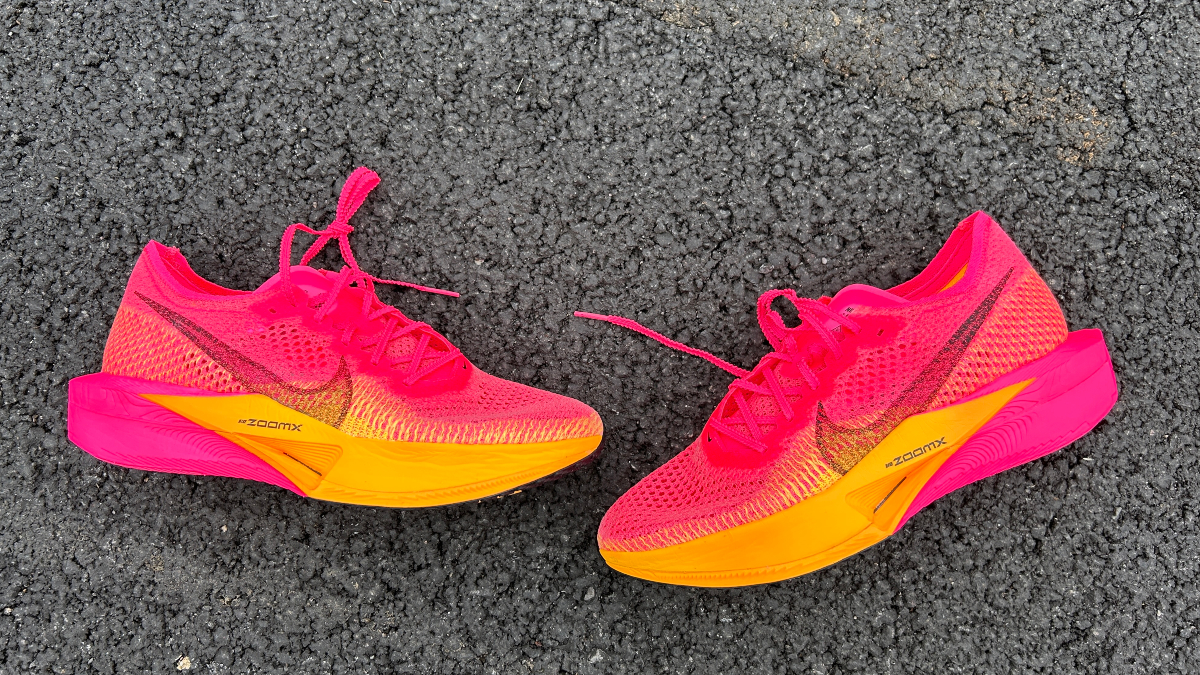Our Verdict
The changes made to the Nike Vaporfly 3 have improved an already great shoe and if you want the best racing shoe available, it’s the one I’d go for.
For
- Bouncier than the Vaporfly 2
- Comfortable but lightweight
- Good for all distances
Against
- More expensive than the Vaporfly 2
You can trust Coach
The Nike Vaporfly was the original super-shoe and it remains one of the best carbon plate running shoes. The Nike Vaporfly NEXT% 2 is the shoe I see worn most often by other runners during road races of any distance, and it’s the yardstick by which every other carbon shoe is measured. Or at least it was.
Now the Nike Vaporfly 3 has been released, I expect it to supersede the Vaporfly 2 and become the top dog. For the most part, the changes to the shoe appear minimal but they are significant in improving the ride. The Vaporfly 3 is the best version of the shoe yet.
Nike Vaporfly 3 Video Review
Nike Vaporfly 3 Review: Price And Availability
The Nike Vaporfly 3 launched in February 2023 and costs $250 in the US and £235 in the UK. That’s the same price as the Vaporfly 2 in the US, but the new shoe is £10 more expensive in the UK. It remains cheaper than the Nike Alphafly NEXT% 2, which is $275/£270. My sample for this review was provided by Pro:Direct Running.
Design And Fit
Making any significant change to the Vaporfly would be a risky business given how popular the shoe is, so Nike has focused on updates that are unlikely to prove controversial: The shoe is lighter and has more ZoomX foam in the midsole.
The first has been achieved by using a more open Flyknit mesh for the upper, which is more breathable as a result. The midsole has been reshaped and cut-outs have been created on the side and bottom of the shoe.

At 7.3oz/206g in my UK size 9, the Vaporfly 3 is around the same as the first Vaporfly 2 I tested, though a fraction lighter than a more recent set (yes, it’s true, the weight of the same shoe in the same size can vary between pairs). Overall, as an average across the range, you can expect the Vaporfly 3 to be a little lighter than the 2, which is never a bad thing in a racing shoe.
To add more foam into the midsole without increasing the stack of the shoe, Nike made the outsole thinner. A little less rubber on the outsole seems a fair price to pay for having 1-2mm more of its bouncy PEBA-based ZoomX foam underfoot. The drop of the shoe is still 8mm and, while Nike doesn’t give the official stack height of the Vaporfly 3, it’s safe to say it’s not far off the 40mm maximum at the heel, set by World Athletics.
Sign up for workout ideas, training advice, reviews of the latest gear and more.
The outsole has impressive rubber coverage on the forefoot with a waffle pattern, along with two strips of rubber at the heel on either side of the shoe. So far, the shoe has gripped well for me, but don’t expect exceptional durability from this thin outsole: This is a shoe to save for your most important workouts and races. If you take it off-road the exposed foam will get torn up quickly.
The shoe fitted well in my normal running shoe size, the same size that I have used for every generation of the Vaporfly.
How I Tested This Shoe
I’ve run 34 miles (55km) in the shoe across three workouts—two on the road and one on the track— and one race, which was a 4.8km leg of a relay. I’ve tested every other generation of the Vaporfly, and have my marathon and 5K PRs in the Vaporfly 2. I’ve also tested most of the best carbon plate running shoes on the market.
Running Performance

My first run in the Vaporfly 3 was a workout running 5K in 17min 30sec, followed by an all-out parkrun in 16min 24sec, then another 5K in 17min 30sec. It was my longest and hardest workout for a while and the Vaporfly 3 felt more comfortable than I expected, while still as aggressive and speedy as previous versions.
Small sidewalls of foam have been added in the middle of the shoe, which improves stability, and the shoe felt surprisingly stable at 5K pace around a couple of hairpin bends. That stability came in handy when doing another road workout on a loop with one tight bend. This was the most enjoyable run I’d done in the shoe: 8 x 400m reps with 200m float recovery, before running two miles at around marathon pace. The run felt like a cruise, and my heart rate was lower than I expected for the paces I was running throughout.
I have also done a track session in the shoe, running 2km, 400m, 300m and 200m reps. It’s still light and direct enough for short reps but has more comfort when cruising through 2km efforts.
I couldn’t wait to race in the Vaporfly 3, and used it for the UK’s Essex Road Relay, running a 4.8km leg. I clocked 14min 56sec running close to my 5K pace, and once again the shoe felt absurdly light while still having the bounce you’d expect from a high-stack shoe. It still felt like it was helping me to turn my legs over in the late stages of the race when every muscle was burning.

The changes have nudged the Vaporfly 3 firmly into the Goldilocks zone for super-shoes: It’s light and nimble enough for short intervals and races, while having enough comfort and propulsion for longer hard runs as well.
There is better comfort and bounce from chunkier shoes like the Alphafly and Adidas Adizero Adios Pro 3, but the trade-off is that they are heavier than the Vaporfly 3. Over the course of a marathon, it feels like it would be a close call between those shoes and the Vaporfly, but the lighter shoe has the edge for shorter distances.
Is The Nike Vaporfly 3 Worth It?
I think the Vaporfly 3 is the best racing shoe and, because of that, its high price will be immaterial to some runners. However, if you choose to focus on value, the buying decision becomes trickier—particularly since the Vaporfly 2 and other older carbon shoes are available for less than $200/£200. If you can get the Vaporfly 2 for as much as $100/£100 less (or another great shoe like the Adidas Adizero Adios Pro 3 or Saucony Endorphin Pro 3 for a similar price), that’s probably the smarter decision.
However, after a couple of years of not being sure exactly which carbon shoe I think is the best overall, right now it feels clear to me that it’s the Vaporfly 3. It’s not light years ahead of the rest—in fact it’s marginal all round—but it’s the one I’ll be reaching for on race day.

Nick Harris-Fry is a journalist who has been covering health and fitness since 2015. Nick is an avid runner, covering 70-110km a week, which gives him ample opportunity to test a wide range of running shoes and running gear. He is also the chief tester for fitness trackers and running watches, treadmills and exercise bikes, and workout headphones.


